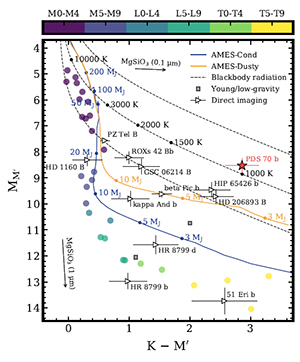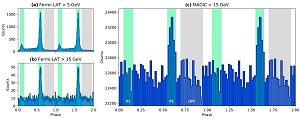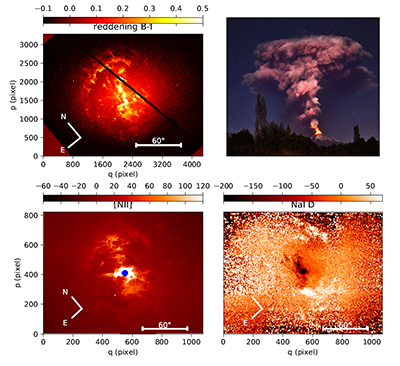2020 Highlights
- Details
- Published on 08 December 2020
Vol. 644
3. Cosmology
From universal profiles to universal scaling laws in X-ray galaxy clusters
The properties of galaxy clusters are shaped mainly by gravity and astrophysical dissipative processes and show remarkable universal behavior once they are rescaled by halo mass and redshift. In this work, the authors show that a universal pressure profile of the intracluster medium (ICM) combined with a halo–mass concentration–redshift relation and the hydrostatic equilibrium equations allow for the reconstruction of the radial profiles of the thermodynamical quantities. When they are integrated over a characteristic scale (such as the commonly used R500 radius), as was done in the observations, they produce the most important physical quantities for characterizing clusters, that is to say, the total mass, gas mass, temperature, and so on. These quantities in turn satisfy universal scaling laws. Using a large sample of clusters from the Planck observations, which have homogeneous X-ray data, the authors calibrate the predicted scaling laws. Their model not only reproduces the observed scaling laws well, but it also provides a way to interpret possible deviations from this self-similar behavior of galaxy clusters. For example, this comparison allows for the quantification of the effect of gas clumping on the studied sample.
- Details
- Published on 26 November 2020
Vol. 643
10. Planets and planetary systems
MIRACLES: atmospheric characterization of directly imaged planets and substellar companions at 4-5 μm. II. Constraints on the mass and radius of the enshrouded planet PDS 70 b

The young (~5 Myr) T Tauri star PDS 70 is an emblematic object for the study of planetary formation. It holds a gapped circumstellar disk in which two embedded planets (PDS 70 b and c) have been directly imaged and show evidence for gas accretion through detection of H alpha emission. The atmospheric and circumplanetary characteristics of these accreting young planets remain poorly understood, and a previous study of the spectral energy distribution of PDS 70 b has suggested a possible combination of emission from a planet atmosphere and a circumplanetary disk. Using VLT/NACO, Stolker et al. report the first detection of PDS 70 b in the Brα and M' filters as well as a tentative detection of PDS 70 c in Brα. PDS 70 b appears significantly redder than any previously imaged planets and brown dwarfs in the color (K-M') - magnitude (M') diagram. Fitting the resulting 1-5 um spectral energy distribution leads to a photospheric temperature Teff = 1193 +/- 20 K and a photospheric radius R = 3.0 +/- 0.2 R_J. In addition, by comparing the object's luminosity with predictions from planet structure models, and taking into account the accretion luminosity as constrained by H alpha, the authors were able to constrain the mass of PDS 70 b to Mp ≈ 0.5–1.5 M_J and its physical radius to Rp ≈ 1–2.5 R_J. The discrepancy between the photospheric and planetary radii may indicate that the planet is embedded in an extended dusty environment, muting molecular features in the object's spectrum, which implies that PDS 70 b not only accretes gas but is also continuously replenished by dust.
- Details
- Published on 24 November 2020
Vol. 643
7. Stellar structure and evolution
Common-envelope evolution with an asymptotic giant branch star
Common envelope evolution is an unresolved problem in binary evolution and a key for the formation of double compact objects. Hydrodynamic simulations show that the orbital energy released during spiral-in is not able to eject the complete envelope. The recombination energy of hydrogen and helium has long been proposed to play a crucial role during the ejection process. The authors carried out three-dimensional hydrodynamic simulations to study the common envelope evolution of a 1Msol early-AGB star with companions of different masses. They clearly demonstrate how recombination energy works to eject the complete envelope.
- Details
- Published on 20 November 2020
Vol. 643
1. Letters to the Editor
Detection of the Geminga pulsar with MAGIC hints at a power-law tail emission beyond 15 GeV

Geminga is the archetypal gamma-ray pulsar with no radio emission. Geminga has been observed up to 30 GeV by the Large Area Telescope (LAT) onboard the Fermi satellite. Previous attempts to detect Geminga by ground-based Cherenkov telescopes were unsuccessful. New observations carried out with the MAGIC telescope have succeeded in revealing a pulsed signal from Geminga up to 75 GeV. Modeling of the spectrum indicates that we are observing Geminga nearly perpendicularly to its rotation axis.
- Details
- Published on 19 November 2020
Vol. 635
4. Extragalactic astronomy
The spatially resolved broad line region of IRAS 09149-6206

The GRAVITY collaboration reports on near-infrared interferometric spectra of the Br-gamma line, resolving the broad line region (BLR) of a nearby active galaxy nucleus (AGN). They are able to measure the size of the BLR (radius 0.075pc) and estimate the mass of the black hole (10^8 M_sun). These results are compatible with average values that have been measured in nearby AGNs through reverberation mapping as well as with the standard M_BH-sigma relation. A surprising result is the 0.14 pc offset between the BLR and the centroid of the hot dust distribution, which is traced by the 2.3 micron continuum. The hot dust is thought to be distributed in a ring, with a measured radius of 0.35 pc, since the high temperature inside the ring sublimates the dust. The offset falls well inside the ring and is thought to be due to the brightness asymmetry of the ring. A clear velocity gradient, almost perpendicular to the offset, is interpreted as the Keplerian rotation of the BLR.
- Details
- Published on 17 November 2020
Vol. 643
7. Stellar structure and evolution
Understanding and improving the timing of PSR J0737-3039B
The double pulsar (PSR J07373039A/B) is the only known system consisting of two radio pulsars in a 2.5hr orbit. Given its unique characteristics, and thanks to its incredible inclination of 89 degrees, it is our best laboratory for general relativity studies. Past studies have concentrated on pulsar A, a recycled millisecond pulsar spinning at 23 ms. Pulsar B is a normal pulsar spinning at 2.8 s. Being less powerful by a factor of ~3500, pulsar B is heavily embedded in the relativistic wind of pulsar A. In this paper, Noutsos and collaborators study pulsar B in detail, notably its emission during the time interval 2004-2008 when the pulsar was detectable before moving away from the line of sight due to geodetic precession. They have developed a model for the pulsar emission beam and its interaction with pulsar A's wind, and they make predictions for 2024 when pulsar B should become visible again. This will allow for more precise testing of the geodetic precession.
- Details
- Published on 17 November 2020
Vol. 643
13. Astronomical instrumentation
The solar gravitational redshift from HARPS-LFC Moon spectra. A test of the general theory of relativity

The general theory of relativity predicts that the wavelengths of solar spectrum lines should be shifted redwards compared to laboratory wavelengths by about 633 m/s in velocity scale. However, the competing blueshift due to granulation phenomena produced by convection makes an accurate observational test of this prediction extremely challenging. This paper presents the most accurate measurement of the solar gravitational redshift to date. The authors employed the laser frequency comb calibration system attached to the HARPS spectrograph on the ESO 3.6 m telescope at La Silla and observations of the sunlight reflected off the moon. State-of-the-art 3D hydrodynamical models of the solar atmosphere were then employed to analyze the spectral lines and measure an accurate gravitational redshift value, which is in full agreement with the theoretical prediction.
- Details
- Published on 17 November 2020
Vol. 643
4. Extragalactic astronomy
Tracing the total molecular gas in galaxies: [CII] and the CO-dark gas
The CO molecule is the tracer of choice for inferring the amount of star-forming molecular hydrogen gas in our Galaxy and other galaxies with similar metallicities. In low-metallicity systems like dwarf galaxies, however, CO can fail to trace the full reservoir of H2 due to the presence of large quantities of molecular gas where CO has been photodissociated by penetrating far ultra-violet radiation. To account for this CO-dark gas, Suzanne Madden and collaborators have systematically studied the use of CII. Using grids of Cloudy models that span a variety of physical conditions and metallicities, these authors provide recipes for deriving total H2 mass estimates from CII observations. Using these models, they find that 70% to 100% of the total H2 mass in dwarf galaxies is not traced by CO(1-0) but is well traced by the λ 158 μm line of CII. When this CO-dark gas is accounted for, the dwarf galaxies are found to follow the same Schmidt-Kennicutt relation identified in more metal-rich disk galaxies.
- Details
- Published on 16 November 2020
Vol. 643
10. Planets and planetary systems
A physical model for the magnetosphere of Uranus at solstice time
The magnetosphere of Uranus is subject to strong seasonal variations. The variability is a consequence of the planet's rotation axis being nearly parallel to its orbital plane, a situation unique in the Solar System. A short rotation period of 17.24h and a large angle between the rotation axis and magnetic dipole axis induces a twist of the planetary magnetic field lines, which are forced to expand downstream of the planet under the action of the supersonic solar wind. Numerical simulations suggest the scale of the twist to be of the order of several hundred times the Uranian radius. Specifically, for the solstice case, simulations show that the planetary field lines expanding downstream of the planet become organized into two distinct interlaced helically structured bundles. This paper presents a detailed physical description of this tail structure for a Uranus-like magnetosphere at solstice, when the solar wind and the rotation axis are quasi-aligned. In a symmetrized version of the original problem, the paper describes the time evolution of a field line from its emergence through the planet's surface to its final position. It shows, for example, that in the planet frame, the asymptotic position is a unique one-dimensional static double helix, independently of the field line's emergence point. It also shows that each strand of a field line approaches its asymptotic position along a spiraling path, similarly to the path followed by a fluid parcel in a tornado.
- Details
- Published on 11 November 2020
Vol. 643
4. Extragalactic astronomy
Dust and gas in the central region of NGC 1316 (Fornax A). Its origin and nature

The central galaxy of the Fornax cluster, NGC 1316, is an early-type galaxy that hosts the radio source FornaxA. NGC 1316 reveals a perturbed dust structure within a 5kpc radius as well as gas that is probably accreted from a merger. Using archival HST/ACS color data and MUSE maps of the ionized gas, the authors studied the central stellar population as well as neutral (NaI D-lines) and ionized ([NII]) velocity fields. The excitation of the ionized gas is thought to come from the post-AGB stars of the old- and intermediate-age stellar population. In the dust-free regions, the interstellar NaI D lines appear in emission, which is indicative of a galactic wind. In the very center, a bipolar velocity field of the ionized gas is observed, which is interpreted as an outflow. There is also an almost edge-on gas and/or dust disk along the major axis of NGC 1316. The dust in NGC 1316 appears to have different origins. There exists an outflow that is curved along the line-of-sight. Nuclear outflows may be important dust-producing machines in galaxies. The dusty gaseous disk looks to be a predecessor for a central dust lane.


